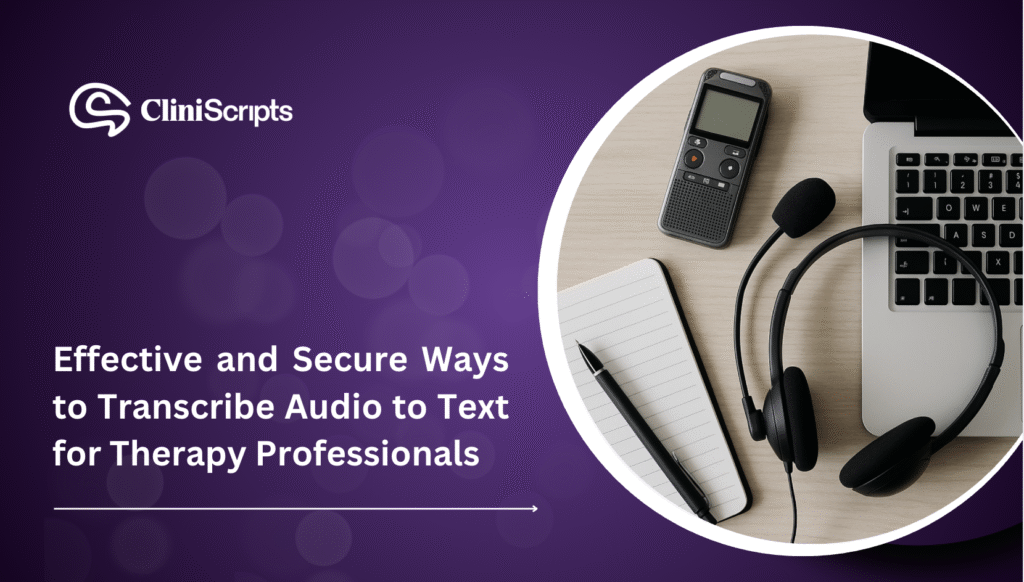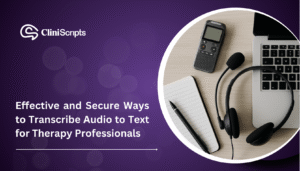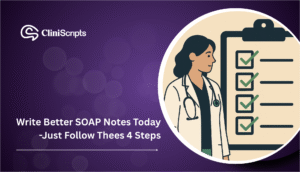Technically Reviewed By Nauman Jaffar
Learn how to transcribe audio to text for therapy sessions while staying HIPAA-compliant. Explore manual, software, and outsourcing options to protect client privacy and improve documentation.
In our fast-paced world, mental health awareness is becoming increasingly important. For mental health professionals in the therapy field, transcribing audio to text recordings of their sessions is essential for enhancing client care, keeping accurate therapy notes, and ensuring thorough documentation for future reference. However, therapists must handle these sensitive recordings with the highest level of care and compliance, especially considering regulations like HIPAA (Health Insurance Portability and Accountability Act). In this blog post, we’ll dive into effective methods for audio transcription while making sure all processes align with HIPAA guidelines.
Why HIPAA Compliance Matters When You Transcribe Audio to Text
- Before we dive into the various transcription options, it’s crucial to grasp why HIPAA compliance is so important in the therapy world. HIPAA establishes national standards to protect patient health information (PHI). Here are the main reasons why staying compliant is essential:
- Protects Client Confidentiality: Therapy session transcriptions can include sensitive details, so keeping this information secure is absolutely vital.
- Legal and Ethical Obligations: Failing to comply can result in legal issues and tarnish a therapist’s reputation, which can erode the trust that clients have in their care providers.
- Quality of Care: Having accurate transcriptions can enhance client outcomes by enabling therapists to monitor progress effectively and customize sessions to meet individual needs.
Top Ways to Transcribe Audio to Text in Therapy: Manual, Software, and Services
When it comes to transcribing audio to text from therapy sessions, therapists have a variety of options to choose from, each bringing its own unique benefits and challenges. Here are some trustworthy methods that comply with HIPAA regulations:
1. Manual Transcription
- For those who like to get their hands dirty, manual transcription means listening to audio recordings and typing out the conversations word for word. Sure, it can take a lot of time, but it gives therapists a chance to really dive into the content, which helps them understand their clients’ needs better. Here are some pros and cons to consider:
- Pros:
- You have complete control over the content and how it’s formatted.
- It’s highly accurate and pays close attention to detail.
- It encourages a deeper understanding of the therapeutic process.
- Cons:
- It can be quite time-consuming, which might take away from time spent with clients.
- It requires good typing skills and the ability to focus for long stretches.
- Pros:
2. Voice Recognition Software
- Voice recognition software has really come a long way in recent years, providing a smart solution for transcribing audio to text with very little manual effort. But it’s super important to pick an application that’s HIPAA-compliant. Tools like Microsoft Azure’s Speech Service and Google Cloud Speech-to-Text can definitely meet those standards if set up properly. Here are some pros and cons to consider:
- Pros:
- Quick and efficient transcription capabilities.
- Many applications can learn and adapt to individual voices, which boosts accuracy over time.
- Cons:
- You might need to do some post-editing to ensure everything is accurate, especially with tricky vocabulary.
- There can be some technical hurdles when setting up a compliant environment.
- Pros:
For therapists exploring AI-powered tools, check out our post on AI Medical Scribe Applications and Why Does Therapy Not Work for Everyone to see how modern documentation technology is reshaping clinical workflows.
3. Outsourced Transcription Services
- If you’re considering options, hiring a professional transcription service that prioritizes HIPAA compliance could be a great choice. These services typically have strong security measures in place, making it easy for therapists to upload their audio files directly. Here are some pros and cons to think about:
- Pros:
- Providers usually promise high accuracy and faster turnaround times.
- This allows therapists to spend more time on their practice instead of getting bogged down with administrative work.
- Cons:
- The costs can accumulate over time, especially if you use the service frequently.
- It’s essential to thoroughly vet these services to ensure they meet HIPAA standards, which means you might need to do some research and possibly enter into contracts.
- Pros:
How to Stay HIPAA-Compliant When You Transcribe Audio to Text
No matter which transcription method you go with, making sure you stay HIPAA compliant involves a few key steps:
- Encryption: Make sure to use software and services that provide encryption both while data is being sent and when it’s stored.
- Business Associate Agreements (BAA): If you’re outsourcing transcription, confirm that your provider is ready to sign a BAA, which shows their commitment to safeguarding PHI.
- Data Minimization: Only keep transcripts that are absolutely necessary for therapy, and make sure to securely delete them when they’re no longer needed.
Final Thoughts on How to Transcribe Audio to Text Safely and Effectively
Transcribing audio to text during therapy sessions can really boost the quality of care that clients receive while also making sure that documentation is both thorough and accurate. However, it’s crucial to keep HIPAA compliance at the forefront. By selecting the right therapy transcription services—whether it’s manual transcription, voice recognition software, or outsourcing—therapists can maintain client confidentiality and trust, which ultimately helps build a stronger therapeutic relationship. Keep in mind that the focus isn’t just on the transcription process itself, but also on how you safeguard the precious information shared during those sensitive sessions.











